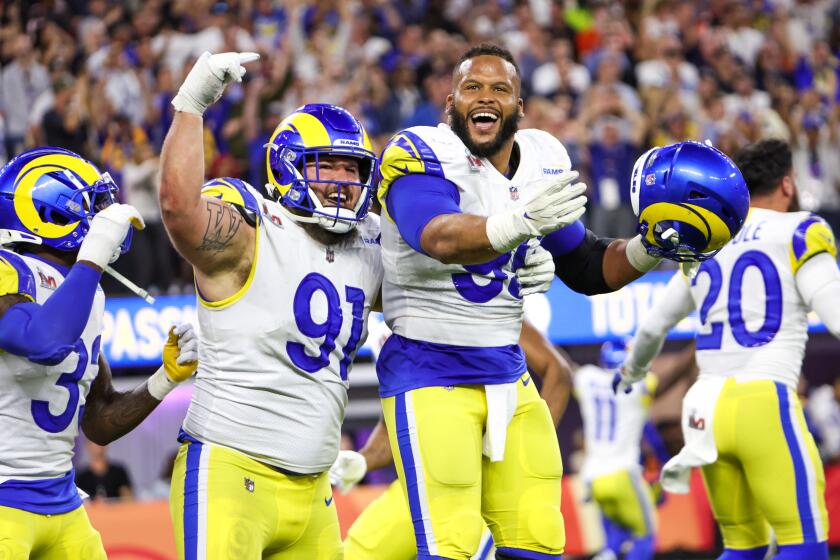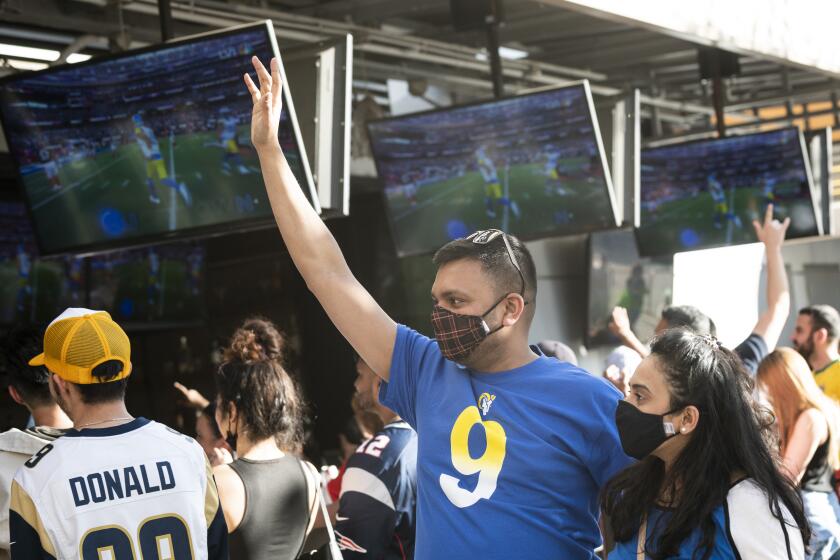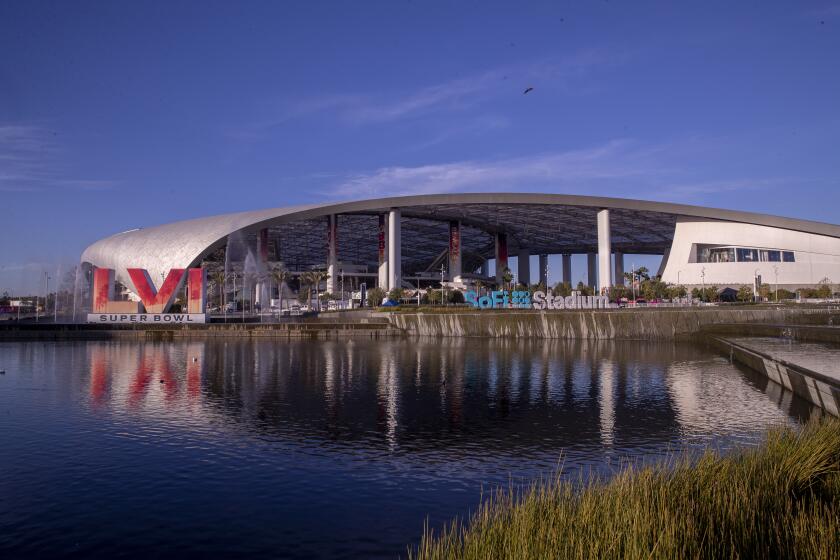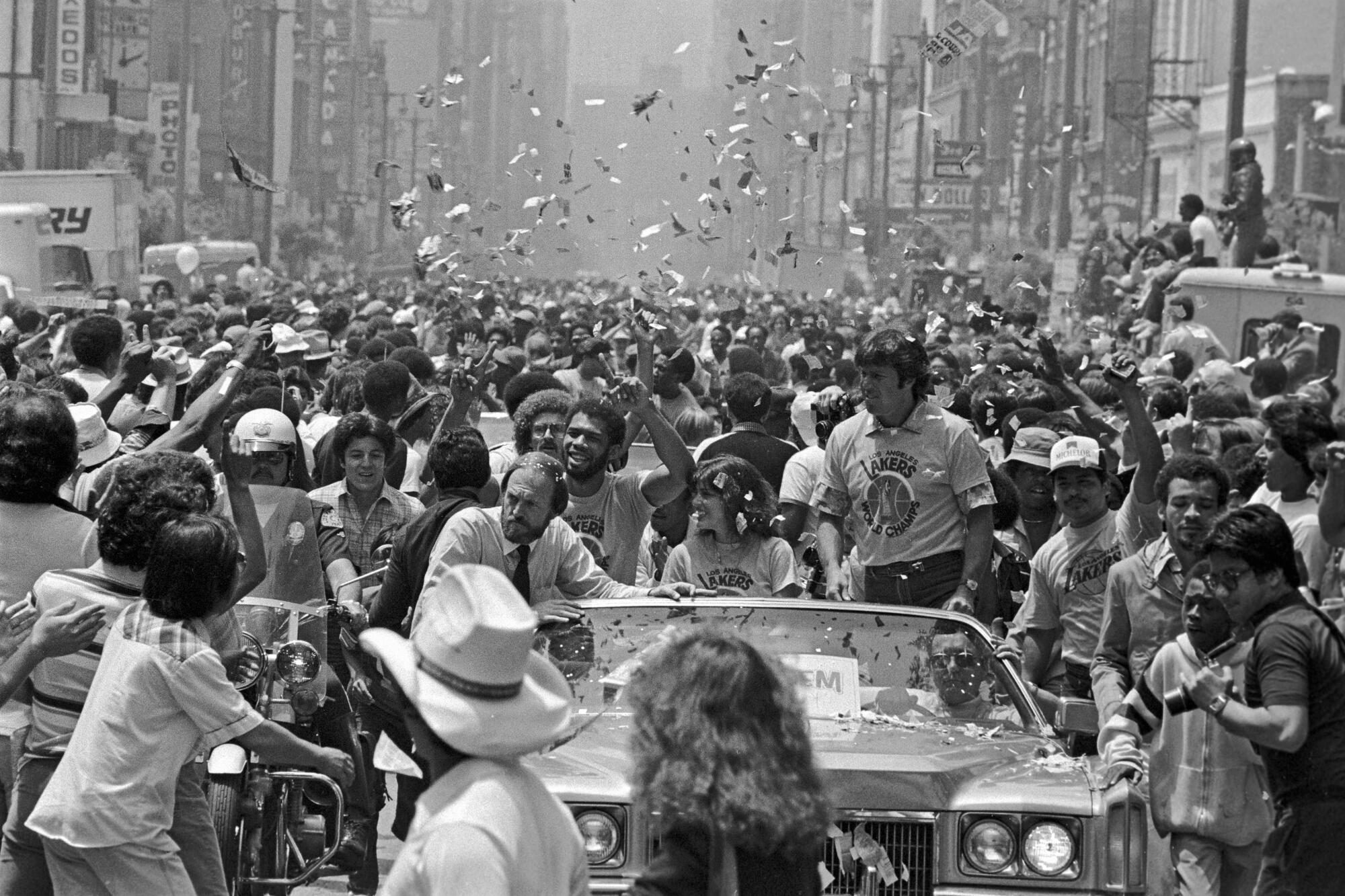
Parades along Broadway to City Hall were once a thing in Los Angeles. Over the decades, routes have become more atomized — and commercial.
- Share via
In 2002, when the Los Angeles Lakers took home the NBA championship title after sweeping the New Jersey Nets, they celebrated, as is customary, with a parade. The proceedings began with a ceremony led by then-Mayor James K. Hahn at City Hall, after which the team paraded south, in double-decker buses, along Figueroa Street to a rally at what was then the Staples Center. The crowd for the rally alone was estimated at 150,000.
At the time, Times sports columnist J.A. Adande wrote, “We need more parades. Too bad it doesn’t look as though we’ll have one for our very own NFL team.”
The Rams defeated the Cincinnati Bengals 23-20 to win their first Super Bowl title in Los Angeles.
Well, go figure. Los Angeles is about to have an actual parade for an actual NFL team — of which it now has two. (Though, sadly, none of them are the Raiders.) On Wednesday, the Los Angeles Rams, who beat the Cincinnati Bengals 23-20 in a nail-biter of a Super Bowl, will get their own parade.
Though to call it a parade is a bit of a stretch. The route travels just over half a mile from the Shrine Auditorium to the Los Angeles Memorial Coliseum in Exposition Park. This is less a parade than the distance you walk to your car at the mall.
It is an improvement, however, from the last time a Los Angeles football team won the Super Bowl. In 1984, when the Raiders beat the team now known as Washington Commanders (and then known by the pejorative Redskins), there was no parade — mainly because the Raiders were too cheap to pay for their share of one. Instead, Mayor Tom Bradley held a rally for the team on the steps of City Hall, where he proceeded to get booed when he attempted to introduce members of the City Council.
The estimates of the 1984 crowd vary: between 2,000 and 11,000, depending on the source. What is certain is that the event was so unmotivating that a number of Raiders players skipped it altogether. A sports writer for UPI based in Washington made gleeful note of the fact that more people turned out to welcome the losing team back to D.C. — an estimated 175,000 to 200,000 people — than did Angelenos to hail the winners.
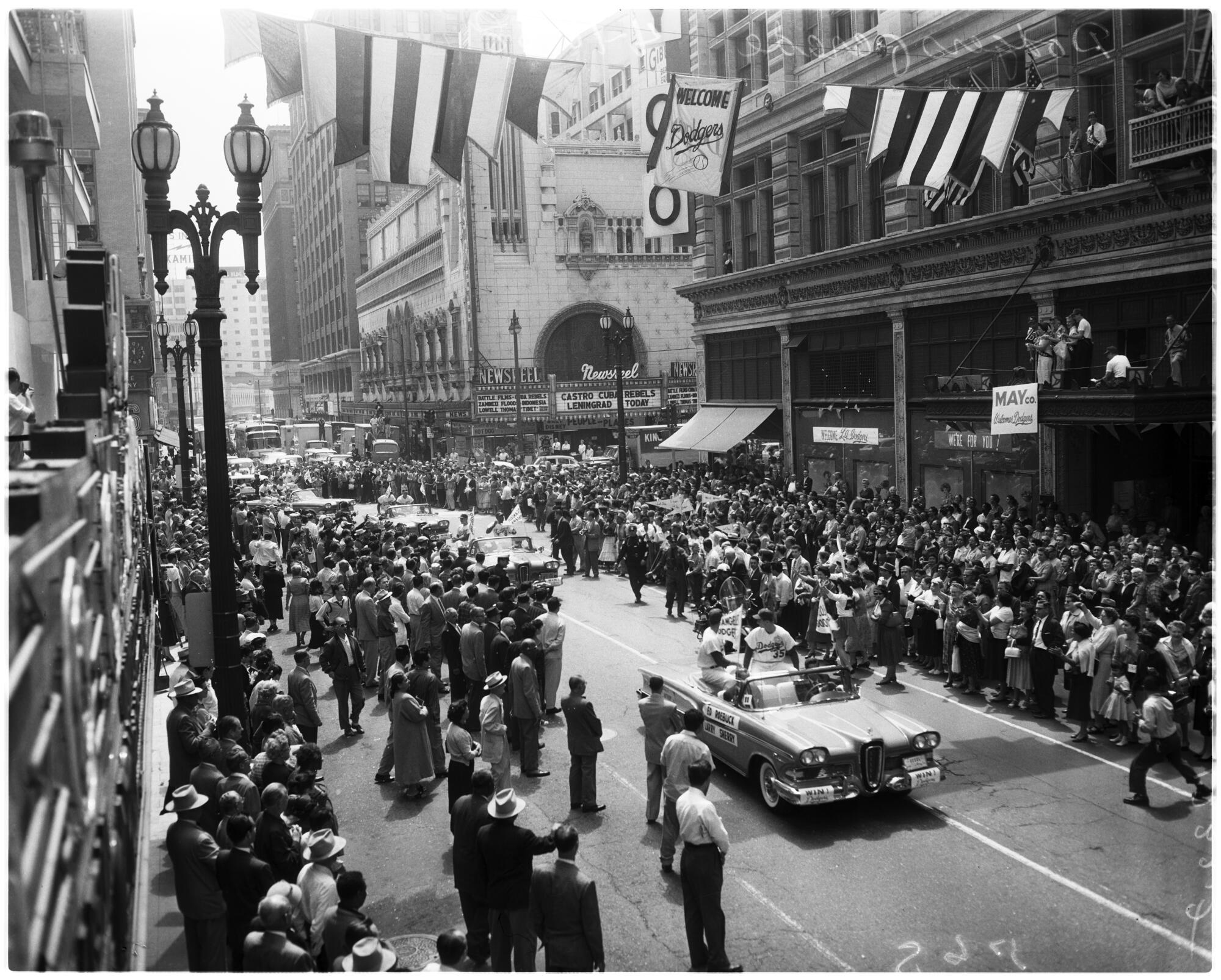
When it comes to parades, Los Angeles has an uneven track record.
Sure, we can churn out a televised parade like nobody’s business, such as the annual Hollywood Christmas Parade and the Rose Parade in Pasadena — highly staged, meticulously planned events that often seem more crafted for the cameras than on-the-ground spectators (and frequently have the effect of turning surrounding neighborhoods into lockdown zones). But we are generally less adept at the impromptu street celebration that offers more equitable access.
Some of that stems from L.A.’s atomized structure and its historically weak public realm. Where do you stage a citywide celebratory event? Who does the location include and who does it exclude? Will the experience be little more than trying to catch a glimpse of a moving vehicle? And what about dreaded parking?
The reason New York City’s lower Broadway, known as the Canyon of Heroes, where the city’s famed ticker tape parades are held, works so well as an impromptu parade site is because its steep verticality turns the city’s architecture into an improvised viewing stand. Los Angeles, which is far less concentrated and far less vertical, offers limited opportunities to stage such events. The Rams’ chosen parade location — around USC — is low-rise, thereby limiting anyone who may casually participate from an open window.
Go to the Rams’ Super Bowl parade if you’re healthy, sure, but wear a mask, COVID-19 experts say.
It hasn’t always been this way.
Historically, impromptu parades in Los Angeles often began on lower Broadway (typically, Broadway and 9th Street), traveled north past the historic theaters, hung a right on 1st Street and then ended up in front of City Hall.
In 1958, when the Dodgers relocated from Brooklyn, they were welcomed with a massive parade on Broadway. Two years later, John F. Kennedy likewise received a Broadway ticker tape parade when he took a final campaign swing through Los Angeles. (Though, rather than ending up at City Hall, he ended his route at Olvera Street for lunch.)
After Kennedy, there was a long dry spell.
In fact, when the Lakers clinched the NBA title in 1980, a spokesperson for Mayor Bradley said that the parade held for the team represented the first ticker tape in L.A. since Kennedy’s visit. (Though ticker tape is a little bit of a misnomer, since L.A. is more about the confetti.) On that occasion, the procession — a convoy of convertibles bearing the team’s members — took the traditional route, traveling up Broadway, with City Hall as its destination. An estimated 6,000 people lined the parade route, and another 8,000 attended a rally. But the city was out of practice: The rally was so crowded and so poorly staged that the team was unable to reach the steps of City Hall as planned. Instead, they waved at the crowd from the roof.
As Times sports writer Scott Ostler wrote of the event, “The rally was badly organized and a dismal flop, but it’s the thought that counts.”
In the wake of that event, parades got more regular, and the planning and staging grew more efficient. Heavily attended processions followed for the Dodgers World Series wins in 1981 and 1988, as well as the Lakers championship wins in 1985 and 1988. By and large, the formula remained the same: up Broadway, followed by a rally at City Hall. Though, in the ’80s when the Lakers were still playing at the Forum, they often followed up their downtown parade with a fan event in Inglewood — a way of acknowledging their home base, which lay in an entirely different city, and a smart way of acknowledging that in Greater Los Angeles, there isn’t a single center, but many.
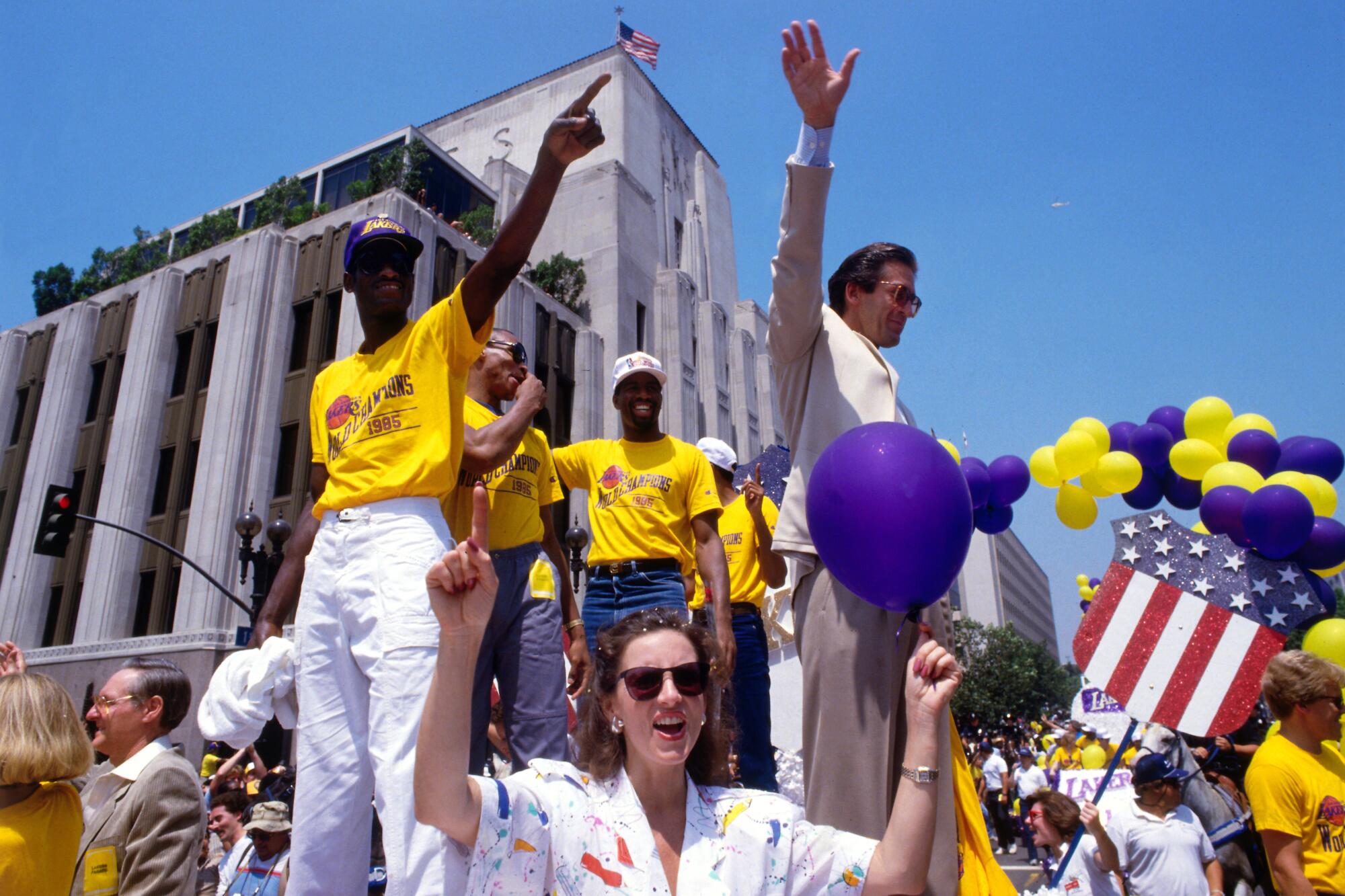
That all changed after the Lakers relocated to the Staples Center in 1999, the venue now known as Crypto.com Arena (and yes, I eye rolled while typing that).
For the record:
6:46 p.m. Feb. 15, 2022An earlier version of this article said the 2000 Lakers championship parade route passed L.A. Live. It had not yet been built.
In 2000, after a 12-year drought, the Lakers defeated the Indiana Pacers to clinch the NBA championship title. That meant a parade. But because of their new downtown home, the route was redrawn: The procession kicked off at the Department of Water and Power Building at 1st and Figueroa, then traveled south on Figueroa to end up at the plaza before the Staples Center. At that point, Lakers parades took a turn from civic space to public-private space. What was once staged in the public realm was shifted to a corporate one.
After the L.A. Live development rose around the Staples Center later in the decade, that led to a very different type of backdrop for victory parades — since L.A. Live bears a very different style of design than the polyglot city. It is an architecture that “is fundamentally not really architecture at all but an extensive series of armatures on which the developer and its tenants can hang logos, video screens and a sophisticated range of lighting effects,” as former Times architecture critic Christopher Hawthorne (now chief design officer for the city of L.A.) astutely described it.
The area around the Staples Center, however, was a good place to contain a large crowd. At the 2000 rally, 250,000 people showed up to cheer on the Lakers. The following year, when the Lakers clinched the title again, the procession was repeated. This time, 550,000 fans turned out.
In 2010, when the Lakers took home the championship title once again (this time beating the Boston Celtics), the parade dispensed with the civic piece altogether. No portion was held at City Hall or any of the buildings around it. Instead, the two-mile route traveled from Staples Center to Exposition Park, where the procession ended with a fan celebration at the Coliseum. It required the parade — which consisted of team members on double-decker buses — to travel under the freeway on at least two occasions. Peak L.A.
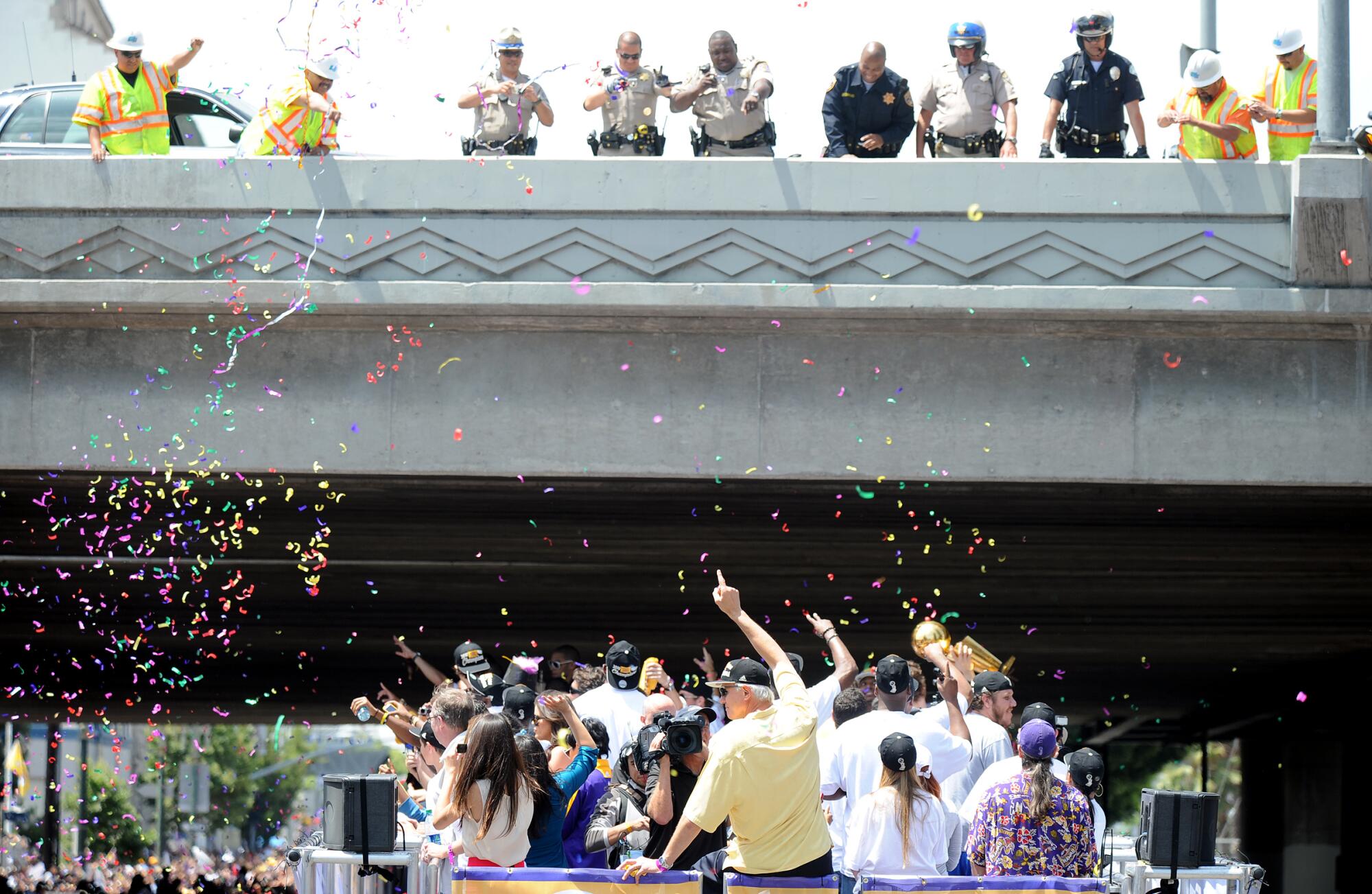
Now it’s the Rams’ turn to parade. What does their route say about them?
Well, the route gives a cold shoulder to L.A.’s civic heart, perhaps an indication of where esteem for the importance of government lies.
It’s also weirdly short. That could partly be due to COVID-19. Neither the Lakers nor the Dodgers had parades to celebrate their championship victories in 2020 because of the pandemic. And the abbreviated route for the Rams could be a way of containing the number of people that will amass on-site. It could also be due to uncertainty over the team’s fan base. The Rams left, and now, quite opportunistically, they are back. Though if they managed to pack SoFi Stadium, which has 70,000 seats, one would assume they could turn out a few thousand fans for a victory celebration lasting more than a few blocks.
A curious element is the location. Certainly, the Rams have a longtime connection to Exposition Park and the Coliseum — having played there for decades before scampering off to St. Louis and then playing there once again while the $5 billion SoFi was under construction. But Inglewood is now the team’s home base, and, as I write this, there are no celebratory events planned in or around their pricey new arena. A terrific oversight, given that Inglewood has bent over backward for the stadium, which has pretty much functioned like an atom bomb of gentrification on the surrounding areas.
SoFi is the largest stadium in the NFL. It’s the league’s first indoor-outdoor stadium. Learn more about its designer.
Though, ultimately, the shift to the Coliseum is understandable. As has been widely reported, the traffic and parking at SoFi Stadium is apocalyptic — largely due to a lack of planning and public transit infrastructure. At the Coliseum, however, you can glide in via the E Line, no parking needed. A far more civilized, not to mention public-minded, approach. Just the sort of thing you want in a parade.
More to Read
The biggest entertainment stories
Get our big stories about Hollywood, film, television, music, arts, culture and more right in your inbox as soon as they publish.
You may occasionally receive promotional content from the Los Angeles Times.
